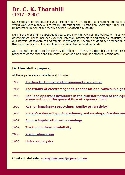Real or imaginary space-time? Reality or relativity?
Real or imaginary space-time? Reality or relativity?
Charles K. Thornhill
In: Hadronic journal. 11. 1996, Nr. 3, S. 209 – 224.
Auch unter: http://www.etherphysics.net/CKT4.pdf
Aufgenommen im GOM-Projekt: 2394 weitere kritische Veröffentlichungen zur Ergänzung der Dokumentation Textversion 1.2 – 2004, Kapitel 4.
Abstract: The real space-time of Newtonian mechanics and the ether concept is
contrasted with the imaginary space-time of the non-ether concept and relativity.
In real space-time (x, y, z, ct) characteristic theory shows that Maxwell’s equations and sound waves in any uniform fluid at rest have identical wave surfaces. Moreover, without charge or current, Maxwell’s equations reduce to the same standard wave equation which governs such sound waves. This is not a general and invariant equation but it becomes so by Galilean transformation to any other reference-frame. So also do Maxwell’s equations which are, likewise, not general but unique to one reference-frame. The mistake of believing that Maxwell’s equations were invariant led to the Lorentz transformation and to relativity; and to the misinterpretation of the differential equation for the wave cone through any point as the quadratic differential form of a Riemannian metric in imaginary space-time (x, y, z, ict). Mathematics is then required to tolerate the same equation being transformed in different ways for different applications. Otherwise, relativity is untenable and recourse must then be made to real spacetime, normal Galilean transformation and an ether with Maxwellian statistics and Planck’s energy distribution.
.
- 26. August 2013
- Artikel
